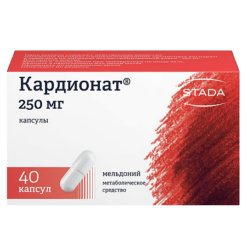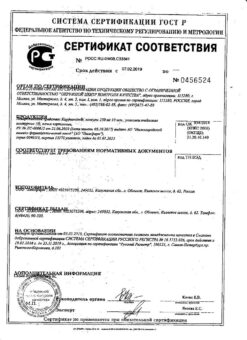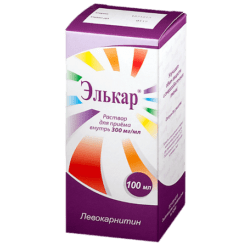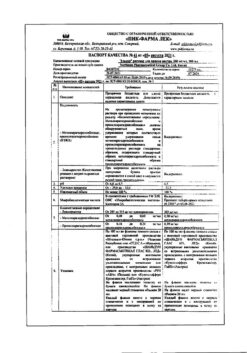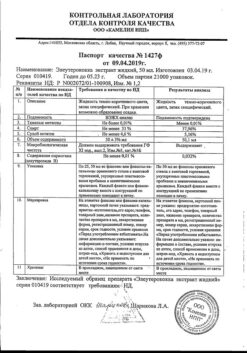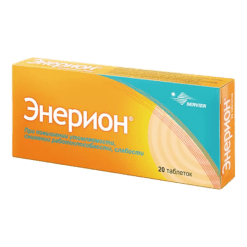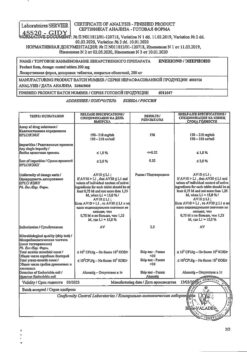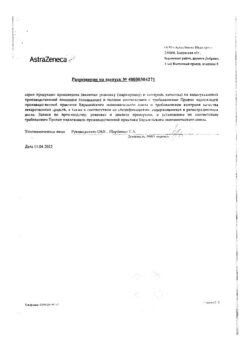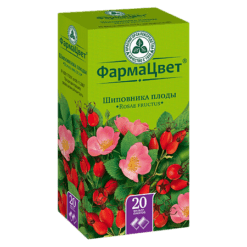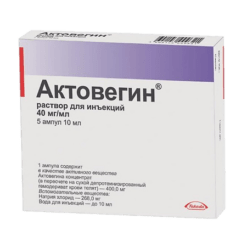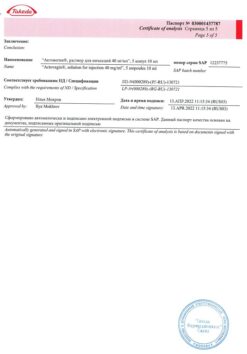No products in the cart.
Allopurinol, tablets 300 mg 30 pcs
€5.76 €4.35
Description
Pharmacotherapeutic group:
antipodagric agent – xanthine oxidase inhibitor
ATC code: [M04AA01]
Pharmacological properties
Firmacodynamics
Allopurinol is a structural analog of hypoxanthine. Allopurinol, as well as its main active metabolite, oxypurinol, inhibit xanthine oxidase, the enzyme that ensures the conversion of hypoxanthine to xanthine, and xanthine to uric acid. Allopurinol reduces the concentration of uric acid in both serum and urine. Thus, it prevents the deposition of uric acid crystals in the tissues and (or) promotes their dissolution. In addition to suppressing purine catabolism in some (but not all) patients with hyperuricemia. large amounts of xanthine and hypoxanthine become available for reformation of purine bases, which leads to inhibition of purine biosynthesis de novo by a feedback mechanism that is mediated by inhibition of hypoxanthine-guanine phosphoribosyl-transferase enzyme. Other metabolites of allopurinol are allopurinol riboside and oxypurinol-7 riboside.
Pharmacokinetics
Allopurinol is quickly and well absorbed from the gastrointestinal tract (up to 90%). When using a single dose of the drug, its concentration in plasma reaches a maximum level within 1.5 hours. About 20% of allopurinol and its metabolites are excreted through the intestine, 10% – by the kidneys. In the liver under the influence of xanthine oxidase allopurinol is converted into oxypurinol, which also inhibits the formation of uric acid. Half-life for allopurinol is 1-2 hours, as it is quickly metabolized to oxypurinol and is extensively excreted by the kidneys through glomerular filtration. The elimination half-life for oxypurinol is about 15 h. Allopurinol is actively reabsorbed in the renal tubules. Allopurinol and its metabolites do not bind to proteins, being distributed in the tissue fluid. The drug penetrates into the breast milk.
Pharmacokinetics in special clinical cases
In renal failure allopurinol and oxipurinol clearance may be significantly decreased, due to which their plasma concentrations increase. Therefore, an appropriate dose reduction is required in patients with renal impairment. In elderly patients there is no significant age-related change in allopurinol pharmacokinetics in the absence of reduced renal function.
Indications
Indications
Diseases accompanied by hyperuricemia (treatment and prevention): gout (primary and secondary), urolithiasis (with the formation of urates).
Hyperuricemia (primary and secondary), which occurs in diseases accompanied by increased breakdown of nucleoproteins and increased levels of uric acid in the blood, incl. with various hematoblastoses (acute leukemia, chronic myeloid leukemia, lymphosarcoma, etc.), with cytostatic and radiation therapy of tumors (including in children), psoriasis, extensive traumatic injuries due to enzyme disorders (Lesch-Nyhan syndrome), as well as with massive therapy with glucocorticosteroids, when due to intense tissue breakdown the amount of purines in the blood. Uric acid nephropathy with impaired renal function (renal failure).
Recurrent mixed oxalate-calcium kidney stones (in the presence of uricosuria).
Pharmacological effect
Pharmacological effect
Pharmacotherapeutic group:
anti-gout drug – xanthine oxidase inhibitor
ATX code: [M04AA01]
Pharmacological properties
Firmacodynamics
Allopurinol is a structural analogue of hypoxanthine. Allopurinol, as well as its main active metabolite, oxypurinol, inhibit xanthine oxidase, an enzyme that converts hypoxanthine into xanthine and xanthine into uric acid. Allopurinol reduces the concentration of uric acid in both serum and urine. Thus, it prevents the deposition of uric acid crystals in tissues and (or) promotes their dissolution. In addition to suppressing purine catabolism in some (but not all) patients with hyperuricemia. a large amount of xanthine and hypoxanthine becomes available for the re-formation of purine bases, which leads to inhibition of de novo purine biosynthesis via a feedback mechanism, which is mediated by inhibition of the enzyme hypoxanthine-guanine phosphoribosyl transferase. Other metabolites of allopurinol are allopurinol riboside and oxypurinol-7 riboside.
Pharmacokinetics
Allopurinol is quickly and well absorbed from the gastrointestinal tract (up to 90%). When using a single dose of the drug, its plasma concentration reaches its maximum level within 1.5 hours. About 20% of allopurinol and its metabolites are excreted through the intestines, 10% by the kidneys. In the liver, under the influence of xanthine oxidase, allopurinol is converted to oxypurinol, which also inhibits the formation of uric acid. The half-life for allopurinol is 1-2 hours, because it is quickly metabolized into oxypurinol and intensively excreted by the kidneys due to glomerular filtration. The half-life for oxypurinol is about 15 hours. Allopurinol is actively reabsorbed in the renal tubules. Allopurinol and its metabolites do not bind to proteins and are distributed in tissue fluid. The drug passes into breast milk.
Pharmacokinetics in special clinical situations
In renal failure, the clearance of allopurinol and oxypurinol can be significantly reduced, and therefore their concentrations in the blood plasma increase. Therefore, appropriate dose reduction is required in patients with renal impairment. In elderly patients, there is no significant age-related change in the pharmacokinetics of allopurinol in the absence of a decrease in renal function.
Special instructions
Special instructions
Drug hypersensitivity syndrome. SSD and heating element
Life-threatening skin reactions such as Stevens-Johnson syndrome and toxic epidermal necrolysis (SJS/TEN) have been reported with the use of allopurinol. Patients should be informed of the symptoms of these reactions (progressive skin rash, often with blistering and mucosal lesions) and carefully monitored for their development. Most often, SJS/TEN develops in the first weeks of taking the drug. If signs and symptoms of SJS/TEN are present, Allopurinol should be immediately discontinued and no longer prescribed!
The manifestations of hypersensitivity reactions to allopurinol can be varied, including maculopapular exanthema, drug hypersensitivity syndrome (DRESS), and SJS/TEN. These reactions are a clinical diagnosis and their clinical manifestations serve as the basis for making appropriate decisions. Therapy with Allopurinol should be discontinued immediately if skin rash or other manifestations of a hypersensitivity reaction occur. Therapy should not be restarted in patients with hypersensitivity syndrome and SJS/TEN.
Corticosteroids may be used to treat hypersensitivity skin reactions.
Chronic renal impairment
Patients with chronic renal impairment are at greater risk of developing allopurinol-related hypersensitivity reactions, including SJS/TEN.
Allele HLA-B*5801
The presence of the HLA-B*5801 allele was found to be associated with the development of allopurinol hypersensitivity syndrome and SJS/TEN. The frequency of the presence of the HLA-B*5801 allele varies in different ethnic groups and can reach 20% in the Han Chinese population, about 12% in Koreans and 1-2% in Japanese and Europeans. The use of genotyping to guide decisions about allopurinol therapy has not been studied. If the patient is known to be a carrier of the HLA-B*5801 allele, then allopurinol should only be prescribed if the benefits of treatment outweigh the risks. The development of hypersensitivity syndrome and SJS/TEN should be monitored very closely. The patient should be informed of the need to immediately discontinue treatment at the first appearance of such symptoms.
Liver and kidney dysfunction
When treating patients with impaired renal or hepatic function, the dose of allopurinol should be reduced. In patients being treated for hypertension or heart failure (for example, patients taking diuretics or ACE inhibitors), concomitant renal dysfunction may occur, so allopurinol should be used with caution in this group of patients.
Asymptomatic hyperuricemia in itself is not an indication for the use of allopurinol. In such cases, improvement in patients’ condition may be achieved through changes in diet and fluid intake along with addressing the underlying cause of hyperuricemia.
Acute attack of gout.
Allopurinol should not be used until the acute attack of gout is completely relieved, since this can provoke an additional exacerbation of the disease.
Similar to uricosuric therapy, initiation of treatment with allopurinol may precipitate an acute attack of gout. To avoid this complication, it is recommended that prophylactic therapy with non-steroidal anti-inflammatory drugs or colchicine be given for at least one month before allopurinol is prescribed. Detailed information about recommended doses, warnings and precautions can be found in the relevant literature.
If an acute attack of gout develops during allopurinol therapy, the drug should be continued at the same dose, and a suitable non-steroidal anti-inflammatory drug should be prescribed to treat the attack.
Xanthine deposits
In cases where the formation of uric acid is significantly increased (for example, malignant tumor pathology and corresponding antitumor therapy, Lesch-Nyhan syndrome), the absolute concentration of xanthine in the urine can in rare cases increase significantly, which contributes to the deposition of xanthine in the tissues of the urinary tract. The likelihood of xanthine deposition in tissues can be minimized by adequate hydration, which ensures optimal urine dilution.
Impaction of uric acid stones
Adequate therapy with allopurinol can lead to the dissolution of large uric acid stones located in the renal pelvis; however, the likelihood of these stones wedging into the ureters is low.
Hemochromatosis
The main effect of allopurinol in the treatment of gout is to inhibit the activity of the enzyme xanthine oxidase. Xanthine oxidase may be involved in the reduction and elimination of iron deposited in the liver. There are no studies demonstrating the safety of allopurinol therapy in the population of patients with hemochromatosis. Patients with hemochromatosis, as well as their blood relatives, should be prescribed allopurinol with caution.
Lactose
Each 300 mg tablet of Allopurinol contains 49 mg of lactose. Therefore, this drug should not be taken by patients with rare hereditary galactose intolerance, lactase deficiency and glucose-galactose malabsorption syndrome.
Impact on the ability to drive vehicles
Allopurinol is used with caution in patients whose activities require high concentration and rapid psychomotor reactions. The degree of restriction or prohibition on driving and operating machinery must be determined by the doctor individually for each patient.
Active ingredient
Active ingredient
Allopurinol
Composition
Composition
1 tablet of the drug contains:
active substance:
allopurinol – 300 mg;
excipients:
lactose monohydrate (milk sugar) – 49 mg;
microcrystalline cellulose – 20 mg;
sodium carboxymethyl starch (Primogel) – 20 mg;
food gelatin – 5 mg;
magnesium stearate – 4 mg;
colloidal silicon dioxide (Aerosil) – 2 mg.
Pregnancy
Pregnancy
There have been no reliable studies on the use of allopurinol during pregnancy and lactation in humans. Allopurinol during pregnancy should be taken only as prescribed by a doctor and only in the absence of a therapeutic alternative, when the disease poses a greater risk to the fetus and mother than taking allopurinol.
If it is necessary to use allopurinol during breastfeeding, you should decide whether to stop breastfeeding or refrain from prescribing the drug.
Contraindications
Contraindications
Hypersensitivity to allopurinol or any other component of the drug; liver failure; severe renal failure (azotemia stage); primary (idiopathic) hemochromatosis; asymptomatic hyperuricemia, acute attack of gout; lactose intolerance, lactase deficiency, glucose-galactose malabsorption syndrome; pregnancy, breastfeeding period, children under 3 years of age.
With caution
Renal failure, chronic heart failure, diabetes mellitus, arterial hypertension, liver dysfunction, hypothyroidism, old age. Patients taking angiotensin-converting enzyme (ACE) inhibitors or diuretics. Children under 15 years of age (prescribed only during cytostatic therapy of leukemia and other malignant diseases, as well as symptomatic treatment of enzyme disorders).
Side Effects
Side Effects
There are no current clinical data to determine the incidence of side effects. Their frequency may vary depending on the dose and whether the drug was prescribed as monotherapy or in combination with other drugs. The classification of the frequency of side effects is based on an approximate estimate; for most side effects there is no data to determine the frequency of their development. The classification of adverse reactions depending on the frequency of occurrence is as follows: very common (≥1/10); common (≥1/100 to infrequent (≥1/1000 to rare (≥1/10000 to very rare) (frequency unknown (cannot be determined from available data).
Adverse reactions associated with allopurinol therapy observed in the post-marketing period are rare or very rare. In the general patient population, most cases are mild. The incidence of adverse events increases with impaired renal and (or) liver function.
Infections and parasitic diseases: very rare: furunculosis.
Blood and lymphatic system disorders: very rare: agranulocytosis, aplastic anemia, thrombocytopenia, granulocytosis, leukopenia, leukocytosis, eosinophilia and aplasia affecting red blood cells only.
Thrombocytopenia, agranulocytosis and aplastic anemia have been reported very rarely, particularly in persons with impaired renal and/or hepatic function, highlighting the need for special caution in these patient groups.
Immune system disorders: uncommon: hypersensitivity reactions; rare: severe hypersensitivity reactions, including skin reactions with epidermal detachment, fever, lymphadenopathy, arthralgia and/or eosinophilia (including Stevens-Johnson syndrome and toxic epidermal necrolysis).
Associated vasculitis or tissue reactions may have a variety of manifestations, including hepatitis, renal involvement, acute cholangitis, xanthine stones, and, in very rare cases, seizures. In addition, the development of anaphylactic shock was very rarely observed. If severe adverse reactions develop, allopurinol therapy should be stopped immediately and not restarted.
Delayed onset multiorgan hypersensitivity (known as drug hypersensitivity syndrome /DRESS/) may develop the following symptoms in various combinations: fever, skin rash, vasculitis, lymphadenopathy, pseudolymphoma, arthralgia, leukopenia, eosinophilia, hepatosplenomegaly, changes in liver function tests, vanishing bile duct syndrome (destruction or disappearance of intrahepatic bile ducts). ducts). If such reactions develop during any period of treatment, Allopurinol should be immediately discontinued and never restarted.
Generalized hypersensitivity reactions developed in patients with impaired renal and (or) liver function. Such cases were sometimes fatal;
very rare: angioimmunoblastic lymphadenopathy. Angioimmunoblastic lymphadenopathy has very rarely been diagnosed after lymph node biopsy for generalized lymphadenopathy. Angioimmunoblastic lymphadenopathy is reversible and regresses after cessation of allopurinol therapy.
Metabolic and nutritional disorders: very rare: diabetes mellitus, hyperlipidemia.
Mental disorders: very rare: depression.
Nervous system disorders: very rare: coma, paralysis, ataxia, neuropathy, paresthesia, drowsiness, headache, perversion of taste.
Visual disturbances: very rare: cataracts, visual disturbances, macular changes.
Hearing and labyrinth disorders: very rare: dizziness (vertigo).
Cardiac disorders: very rare: angina, bradycardia.
Vascular disorders: very rare: increased blood pressure.
Gastrointestinal disorders: uncommon: vomiting, nausea, diarrhea (nausea and vomiting were observed in earlier clinical studies, but more recent observations have confirmed that these reactions are not a clinically significant problem and can be avoided by prescribing allopurinol after meals); very rare: recurrent hematemesis, steatorrhea, stomatitis, changes in bowel movements; frequency unknown: abdominal pain.
Disorders of the liver and biliary tract: uncommon: asymptomatic increase in the concentration of liver enzymes (increased levels of alkaline phosphatase and transaminases in the blood serum); rare: hepatitis (including necrotizing and granulomatous forms).
Liver dysfunction may develop without obvious signs of generalized hypersensitivity.
Skin and subcutaneous tissue disorders: common: rash; rare: severe skin reactions: Stevens-Johnson syndrome (SJS) and toxic epidermal necrolysis (TEN); very rare: angioedema, local drug rash, alopecia, hair bleaching.
Skin adverse reactions are the most common in patients taking allopurinol. During drug therapy, these reactions can develop at any time. Skin reactions may include itching, maculopapular and scaly rashes. In other cases, purpura may develop. In rare cases, exfoliative skin lesions (SSD/TEN) are observed. If such reactions develop, allopurinol therapy should be discontinued immediately. If the skin reaction is mild, then allopurinol can be resumed at a lower dose (for example, 50 mg per day) after these changes have resolved.
Subsequently, the dose can be gradually increased. If skin reactions recur, allopurinol therapy should be stopped and not restarted, since further use of the drug may lead to the development of more severe hypersensitivity reactions.
According to existing information, during therapy with allopurinol, angioedema developed in isolation, as well as in combination with symptoms of a generalized hypersensitivity reaction.
Musculoskeletal and connective tissue disorders: very rare: myalgia.
Renal and urinary tract disorders: very rare: hematuria, renal failure, uremia; frequency unknown: urolithiasis.
Reproductive system and mammary gland disorders: very rare: male infertility, erectile dysfunction, gynecomastia.
General disorders and disorders at the injection site: very rare: swelling, general malaise, general weakness, fever.
According to existing information, during therapy with allopurinol, fever developed both in isolation and in combination with symptoms of a generalized hypersensitivity reaction.
Reports of possible adverse reactions
If adverse reactions occur, including those not listed in this instruction, you should stop using the drug.
In the post-registration period, any information about possible adverse reactions is important, since these reports help to continuously monitor the safety of the drug.
Healthcare professionals are required to report any suspected adverse reactions to local pharmacovigilance authorities.
Interaction
Interaction
6-mercaptopurine and azathioprine
Azathioprine is metabolized to form 6-mercaptopurine, which is inactivated by the enzyme xanthine oxidase. When 6-mercaptopurine or azathioprine therapy is combined with allopurinol, patients should be given only one-fourth the usual dose of 6-mercaptopurine or azathioprine because inhibition of xanthine oxidase activity increases the duration of action of these compounds.
Vidarabine (adenine arabinoside)
In the presence of allopurinol, the half-life of vidarabine is increased. When these drugs are used concomitantly, special caution should be exercised regarding increased toxic effects of therapy.
Salicylates and uricosurics
The main active metabolite of allopurinol is oxypurinol, which is excreted by the kidneys in a manner similar to uric acid salts. Therefore, drugs with uricosuric activity such as probenecid or high doses of salicylates. may enhance the excretion of oxypurinol. In turn, increased excretion of oxypurinol is accompanied by a decrease in the therapeutic activity of allopurinol, however, the significance of this type of interaction must be assessed individually in each case.
Chlorpropamide
With the simultaneous use of allopurinol and chlorpropamide, in patients with impaired renal function, the risk of developing long-term hypoglycemia increases, since allopurinol and chlorpropamide compete with each other at the stage of tubular excretion.
Anticoagulants coumarin derivatives
When used simultaneously with allopurinol, an increase in the effects of warfarin and other anticoagulants of coumarin derivatives was observed. In this regard, it is necessary to carefully monitor the condition of patients receiving concomitant therapy with these drugs.
Phenytoin
Allopurinol is able to inhibit the oxidation of phenytoin in the liver, but the clinical significance of this interaction has not been established.
Theophylline
Allopurinol is known to inhibit theophylline metabolism. This interaction can be explained by the participation of xanthine oxidase in the process of theophylline biotransformation in the human body. Serum theophylline concentrations should be monitored when concomitant allopurinol therapy is initiated. and also with an increase in the dose of the latter.
Ampicillin and amoxicillin
In patients receiving ampicillin or amoxicillin and allopurinol concomitantly, an increased incidence of skin reactions was observed compared with patients who did not receive such concomitant therapy. The cause of this type of drug interaction has not been established. However, in patients receiving allopurinol, it is recommended that other antibacterial drugs be prescribed instead of ampicillin and amoxicillin.
Cytotoxic drugs (cyclophosphamide, doxorubicin, bleomycin, procarbazine, mechlorethamine)
In patients suffering from tumor diseases (except leukemia) and receiving allopurinol, increased suppression of bone marrow activity by cyclophosphamide and other cytotoxic drugs was observed. However, according to the results of controlled studies in patients receiving cyclophosphamide, doxorubicin, bleomycin, procarbazine and/or mechlorethamine (chlormethine hydrochloride), concomitant therapy with allopurinol did not increase the toxic effects of these cytotoxic drugs.
Cyclosporine
According to some reports, plasma concentrations of cyclosporine may increase during concomitant therapy with allopurinol. When using these drugs simultaneously, the possibility of increased toxicity of cyclosporine must be taken into account.
Didanosine
In healthy volunteers and HIV-infected patients receiving didanosine, during concomitant therapy with allopurinol (300 mg per day), an approximately two-fold increase in didanosine Cmax (maximum drug concentration in blood plasma) and AUC (area under the concentration-time curve) of didanosine was observed. The half-life of didanosine did not change. In general, simultaneous use of these drugs is not recommended. If concomitant therapy is unavoidable, a dose reduction of didanosine and careful monitoring of the patient may be necessary.
ACE inhibitors
Concomitant use of ACE inhibitors with allopurinol is accompanied by an increased risk of leukopenia, so these drugs should be combined with caution.
Thiazide diuretics
Concomitant use of thiazide diuretics, including hydrochlorothiazide, may increase the risk of allopurinol-related hypersensitivity side effects, especially in patients with impaired renal function.
Overdose
Overdose
Symptoms: nausea, vomiting, diarrhea, dizziness, oliguria. Most symptoms of allopurinol overdose can be alleviated by increased renal excretion with plenty of fluid intake and a corresponding increase in diuresis.
Treatment: forced diuresis; allopurinol and its metabolites are eliminated by hemodialysis and peritoneal dialysis.
Storage conditions
Storage conditions
Store in a place protected from light at a temperature not exceeding 30 °C.
Keep out of the reach of children.
Shelf life
Shelf life
3 years. Do not use after the expiration date stated on the package.
Manufacturer
Manufacturer
Ozon, Russia
Additional information
| Shelf life | 3 years. Do not use after the expiration date printed on the package. |
|---|---|
| Conditions of storage | Store in the dark place at temperatures under 30 ° C. Keep out of reach of children. |
| Manufacturer | Ozon, Russia |
| Medication form | pills |
| Brand | Ozon |
Related products
Buy Allopurinol, tablets 300 mg 30 pcs with delivery to USA, UK, Europe and over 120 other countries.


